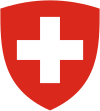1935 Swiss federal election
Appearance
| This article is part of a series on the |
 |
|---|
|
|
Federal elections were held in Switzerland on 27 October 1935.[1] The Social Democratic Party emerged as the largest party in the National Council, winning 50 of the 187 seats.[2]
Results
National Council
| Party | Votes | % | Seats | +/– |
|---|---|---|---|---|
| Social Democratic Party | 255,843 | 28.0 | 50 | +1 |
| Free Democratic Party | 216,664 | 23.7 | 48 | –4 |
| Swiss Conservative People's Party | 185,052 | 20.3 | 42 | –2 |
| Party of Farmers, Traders and Independents | 100,300 | 11.0 | 21 | –9 |
| Ring of Independents | 37,861 | 4.1 | 7 | New |
| Liberal Democratic Party | 30,476 | 3.3 | 6 | 0 |
| Young Farmers | 28,161 | 3.1 | 4 | New |
| National Front | 13,740 | 1.5 | 1 | New |
| Communist Party | 12,569 | 1.4 | 2 | 0 |
| Liberal Socialist Party | 11,078 | 1.2 | 0 | New |
| Social-Political Group | 10,665 | 1.2 | 3 | +1 |
| Evangelical People's Party | 6,780 | 0.7 | 1 | 0 |
| National Union | 4,334 | 0.5 | 1 | New |
| General People's List | 1 | New | ||
| Other parties | 0 | – | ||
| Invalid/blank votes | 22,233 | – | – | – |
| Total | 935,756 | 100 | 187 | 0 |
| Registered voters/turnout | 1,194,910 | 78.3 | – | – |
| Source: Mackie & Rose,[3] Nohlen & Stöver, | ||||
Council of the States
In several cantons the members of the Council of the States were chosen by the cantonal parliaments.[4]
| Party | Seats | +/– |
|---|---|---|
| Swiss Conservative People's Party | 19 | +1 |
| Free Democratic Party | 15 | –4 |
| Party of Farmers, Traders and Independents | 3 | 0 |
| Social Democratic Party | 3 | +1 |
| Liberal Democratic Party | 2 | +1 |
| Social-Political Group | 0 | 0 |
| Other parties | 2 | +1 |
| Total | 44 | 0 |
| Source: Nohlen & Stöver | ||
